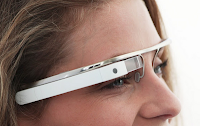As Google makes a media splash about a potential new product, a augmented reality headset that could shine Google information into your eyes as you walk about, I couldn’t help but compare their offering to the googles that appeared in my recent time travel novel, The Copper Room.
Google’s product is firmly rooted in current tech, and as seen in their promo image, it rides like an augmented glasses frame with a bundle of stuff clamped on the side. Google’s promo video gives an idea of what it might be capable of doing.
I find the demo amusing. Where’s the advertisements?
In the novel, the googles were handed out free, and were simple wrap around googles with a non-reflective surface that tended to make them nearly invisible in everyday use — I get to cheat and use tech from 2000 years in the future. While the goggles were free, the instant you put them on, advertisements customized to you are displayed on every flat surface.
This is one important difference between Google Glass and the goggles. The goggles cover both eyes and are thus able to provide 3D displays, laying out information on top of real surfaces, just like the computer enhanced line of scrimmage on football fields on TV, and the fake advertisements around telecast baseball diamonds. In this future world, the walls are blank, until you put on the goggles.
Take a look at how Goggle Glass does it. Simple iconic displays appear between you and the real world. Since it appears to be shining the info into one eye, the 3D effects are unavailable.
Poor people get blasted with thousands of images. Once you enter your banking information, the adverts get more sophisticated, and if you pay, you can clean away most of the clutter and can concentrate on more valuable information. Rather than video conferencing with a face in a window, in addition, the 3D images could create a transparent, full-sized avatar to talk to. When talking face to face with real people, surface effects something like seeing someone’s aura could provide additional information like biometric cues to their mood or truthfulness. Eye tracking and audio information through the earpieces could provide a universal translator.
So, I guess my opinion of the Google Glass project is that it is an interesting first step. I want one that looks invisible rather than making me look like part of the Borg, and that provides a rich spectrum of information rather than a handful of Google products.

